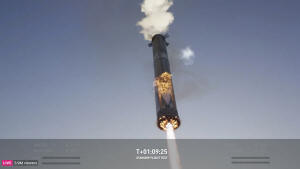In an engineering feat, mechanical SpaceX arms catch Starship rocket
booster back at the launch pad
 Send a link to a friend
Send a link to a friend
 [October 14, 2024]
By MARCIA DUNN [October 14, 2024]
By MARCIA DUNN
SpaceX pulled off the boldest test flight yet of its enormous Starship
rocket on Sunday, catching the returning booster back at the launch pad
with mechanical arms.
A jubilant Elon Musk called it “science fiction without the fiction
part.”
Towering almost 400 feet (121 meters), the empty Starship blasted off at
sunrise from the southern tip of Texas near the Mexican border. It arced
over the Gulf of Mexico like the four Starships before it that ended up
being destroyed, either soon after liftoff or while ditching into the
sea. The previous one in June had been the most successful until
Sunday's demo, completing its flight without exploding.
This time, Musk, SpaceX's CEO and founder, upped the challenge for the
rocket that he plans to use to send people back to the moon and on to
Mars.
At the flight director's command, the first-stage booster flew back to
the launch pad where it had blasted off seven minutes earlier. The
launch tower's monstrous metal arms, dubbed chopsticks, caught the
descending 232-foot (71-meter) stainless steel booster and gripped it
tightly, dangling it well above the ground.
“The tower has caught the rocket!!” Musk announced via X. “Big step
towards making life multiplanetary was made today.”
Company employees screamed in joy, jumping and pumping their fists into
the air. NASA joined in the celebration, with Administrator Bill Nelson
sending congratulations.
Continued testing of Starship will prepare the nation for landing
astronauts at the moon’s south pole, Nelson noted. NASA’s new Artemis
program is the follow-up to Apollo, which put 12 men on the moon more
than a half-century ago.
“Folks, this is a day for the engineering history books,” SpaceX
engineering manager Kate Tice said from SpaceX headquarters in
Hawthorne, California.
“Even in this day and age, what we just saw is magic,” added company
spokesman Dan Huot from near the launch and landing site. “I am shaking
right now.”
It was up to the flight director to decide, in real time with a manual
control, whether to attempt the landing. SpaceX said both the booster
and launch tower had to be in good, stable condition. Otherwise, it was
going to end up in the gulf like the previous ones. Everything was
judged to be ready for the catch.

[to top of second column]
|

This image provided by SpaceX shows SpaceX's mega rocket booster
returning to the launch pad to be captured during a test flight
Sunday, Oct. 13, 2024, in Boca Chica, Texas. (SpaceX via AP)

The retro-looking spacecraft launched by the booster continued
around the world, soaring more than 130 miles (212 kilometers) high.
An hour after liftoff, it made a controlled landing in the Indian
Ocean, adding to the day's achievement. Cameras on a nearby buoy
showed flames shooting up from the water as the spacecraft impacted
precisely at the targeted spot and sank, as planned.
“What a day,” Huot said. “Let's get ready for the next one.”
The June flight came up short at the end after pieces came off.
SpaceX upgraded the software and reworked the heat shield, improving
the thermal tiles.
SpaceX has been recovering the first-stage boosters of its smaller
Falcon 9 rockets for nine years, after delivering satellites and
crews to orbit from Florida or California. But they land on floating
ocean platforms or on concrete slabs several miles from their launch
pads — not on them.

Recycling Falcon boosters has sped up the launch rate and saved
SpaceX millions. Musk intends to do the same for Starship, the
biggest and most powerful rocket ever built with 33 methane-fuel
engines on the booster alone.
Musk said the captured Starship booster looked to be in good shape,
with just a little warping of some of the outer engines from all the
heat and aerodynamic forces. That can be fixed easily, he noted.
NASA has ordered two Starships to land astronauts on the moon later
this decade. SpaceX intends to use Starship to send people and
supplies to the moon and, eventually Mars.
___
The Associated Press Health and Science Department receives support
from the Howard Hughes Medical Institute’s Science and Educational
Media Group. The AP is solely
All contents © copyright 2024 Associated Press. All rights reserved |